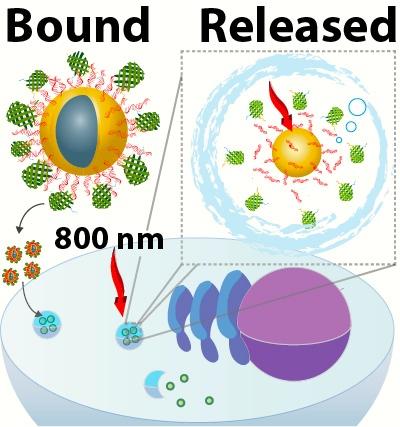

A hollow gold nanoshell with a modular nickel linking layer (upper left) exposed to a laser (800 nm) shows the cellular uptake and protein release.
Credit: UCSB
Optogenetics, which uses light to control cellular events, is poised to become an important technology in molecular biology and beyond. The Reich Group in UC Santa Barbara's Department of Chemistry and Biochemistry has made a major contribution to this emergent field by developing a light-activated nanocarrier that transports proteins into cells and releases them on command. The findings appear in the journal Molecular Pharmaceutics.
Using inorganic gold nanoshells and a near-infrared laser, UCSB biochemistry professor Norbert Reich and graduate student Demosthenes Morales demonstrate for the first time a method that affords both spatial and temporal control over protein delivery in cells.
“You can point the laser at cells where and when you want a particular protein to be turned on,” Reich said. “And that means you can ask biological questions that you could never ask before because you're able to say I want this one cell to do this.”
The researchers exploited the receptors on prostate cancer cells, which rely on the recognition of a C-end rule internalizing peptide that has been fused to the end of a green fluorescent protein. This peptide is very specific for the receptor and once the two meet, it actually takes in the protein-loaded nanoparticles and shepherds them into the cell via endocytosis, a process that brings large molecules into cells.
The team used a modular nickel linking layer on the surface of the nanoparticles that is able to support different kinds of proteins fused with a polyhistidine tag commonly found on proteins expressed in labs. “We want this to be applicable to any type of protein that has a polyhistidine tail,” lead author Morales said, “so if you synthesize or grow proteins in a lab, you can easily load the protein onto our nanoparticles.”
While the Reich Group's hollow gold nanoshells are effective carriers, transporting large biomolecules such as proteins into cells is only half the battle. In order for the protein to be effective once inside the cell, it must be released from the vesicle (endosome) holding it. The UCSB design enables that to happen.
When we excite these hollow gold nanoshells with light, the surface of the nanoparticle becomes somewhat hot,” Morales said. “The light not only releases the cargo that's on the surface but also causes the formation of vapor bubbles, which expand and eventually pop the vesicle, allowing for endosome escape.”
The Reich Group's construct is designed around the advantage of protein delivery's specificity. “The best thing about our platform is that it has a wide range of applicability,” Morales noted. “Not only do we have the ability to target with a laser where and when we want to release our therapeutic, but we also leverage the fact that the protein itself is very specific. We have specificity in terms of time and we have specificity toward the target. This is why proteins are very fascinating as a potent therapeutic.”
According to Reich, this technology has important implications for basic research. “Biologists are going to make use of this kind of technology but they aren't going to develop it,” Reich said. “There are a few people on campus who could use this technology so we have a unique opportunity at UCSB to be the lead in interfacing between the developers and the users.”












